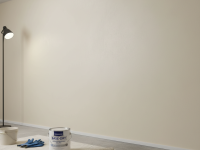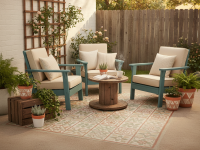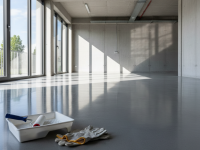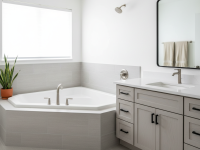Ah, summer! The season of long days, backyard barbecues, and… sweltering indoor temperatures? We’ve all been there: cranking up the AC, watching the energy bill climb, and still feeling like we’re living in a sauna. But what if I told you there’s a simpler, often overlooked solution right at your windows? That’s right, choosing the right window treatments can dramatically reduce the heat entering your home, making your space more comfortable and your wallet happier.
I’ve personally battled the summer heat in several homes, from an old Victorian with drafty windows to a modern apartment with floor-to-ceiling glass. Through trial and error (and a lot of research!), I’ve discovered which window treatments truly deliver on their promise of coolness. This isn’t just about aesthetics; it’s about smart design that fights the sun’s relentless rays. So, let’s dive into the world of window wisdom and find the perfect cool-down solution for your sanctuary!
Understanding How Heat Sneaks In Through Your Windows
Before we explore the solutions, it’s helpful to understand the problem. Heat primarily enters your home through windows in three ways:
- Radiation: This is the most significant culprit. The sun’s infrared rays pass through glass and heat up objects inside your room (furniture, floors), which then radiate that heat into the air.
- Conduction: Heat directly transfers through the glass itself, especially with older, single-pane windows.
- Convection: Hot air outside can seep through gaps and cracks around your window frames, or warm air inside rises and cool air sinks, creating circulation that distributes heat.
Our goal with window treatments is to block, reflect, or absorb this heat before it ever gets a chance to make you uncomfortable.
The Power of Reflectivity: Reflective Window Films
Let’s start with a highly effective, often budget-friendly option: reflective window films. These are like sunglasses for your windows! I once lived in an apartment with a massive west-facing window that turned my living room into a greenhouse every afternoon. After installing a reflective film, the difference was night and day. Seriously, it felt like someone had just turned down the sun’s intensity knob by half.
Pros:
- Excellent Heat Rejection: High-quality films can block up to 78% of solar heat.
- UV Protection: They block almost all harmful UV rays, protecting your furniture and flooring from fading.
- Glare Reduction: Say goodbye to squinting at your screen!
- Relatively Inexpensive: Especially compared to replacing windows or adding new treatments.
- DIY-Friendly: Many films can be installed by homeowners with a bit of patience.
Cons:
- Can Darken Rooms: While some films are very clear, the most effective ones can reduce natural light.
- Affects Exterior Look: Some films can give your windows a mirrored or tinted appearance from the outside.
- Not for All Windows: Some specific types of low-e or double-pane windows might not be suitable for certain films, as it can cause thermal stress (always check with the film manufacturer).
Layer Up for Maximum Defense: Thermal Curtains and Drapes
If you’re looking for a classic solution that adds a touch of elegance, thermal curtains or drapes are your best friends. I’ve relied on blackout thermal curtains in bedrooms for years, and they’re not just great for sleeping in; they’re fantastic heat blockers. The key is their multi-layered fabric, often with a thermal lining designed to insulate.
What to Look For:
- Thermal Lining: This is crucial. It’s usually a thick, dense fabric or even multiple layers that prevent heat transfer.
- Thick Fabric: Heavier fabrics naturally offer more insulation.
- Proper Fit: Ensure they extend beyond the window frame on all sides and ideally “kiss” the floor to minimize heat leakage.
- Light Color on the Back: A lighter color facing the outside will reflect more solar radiation.
Pros:
- Superior Insulation: They create an insulating barrier that traps air, preventing heat from radiating into the room.
- Excellent Light Blocking: Ideal for bedrooms or media rooms.
- Aesthetic Appeal: Available in countless styles, colors, and patterns to match any decor.
- Noise Reduction: The thick fabric can also dampen outside noise.
Cons:
- Can Be Bulky: Heavy drapes might not suit minimalist decor.
- Block Natural Light: When closed, they block out most natural light, which can make rooms feel darker.
- Require Space: Need enough wall space on either side of the window for them to be drawn back completely.
The Versatility of Blinds: Cellular, Venetian, and Vertical
Blinds offer a fantastic range of options, each with unique cooling properties. Let’s break down the most effective ones:
Cellular (Honeycomb) Blinds: The Insulators
These are hands down my top pick for blinds when it comes to heat control. Their unique honeycomb structure creates air pockets that act as fantastic insulators. I recommend them to anyone looking for an effective blend of style and energy efficiency.
- Pros: Excellent insulation, available in various opacities (light filtering to blackout), top-down/bottom-up options for privacy and light control.
- Cons: Can be delicate, harder to clean deep inside the cells.
Venetian Blinds: The Light Masters
While not as insulating as cellular blinds, Venetian blinds (with horizontal slats) offer incredible light control. You can angle the slats to reflect sunlight upwards towards the ceiling, diffusing light without direct heat entry. Just remember to tilt them correctly!
- Pros: Precise light and privacy control, relatively affordable.
- Cons: Gaps between slats can allow heat, can be noisy when moved, dust traps.
Vertical Blinds: The Large Window Solution
Great for patio doors or large windows, vertical blinds can also help with heat, especially if they have a reflective backing. Like Venetian blinds, tilting the slats correctly is key.
- Pros: Ideal for large openings, easy to clean, offer good light control.
- Cons: Less insulating than cellular, can be noisy, might look dated depending on material.
Shades for Every Style and Need: Roller, Roman, and Solar Shades
Shades offer a sleek, streamlined look, and many are designed with heat reduction in mind.
Roller Shades: The Sleek & Simple
Roller shades are understated and effective. For cooling, opt for shades made from a heat-reflective or blackout fabric. I’ve used simple blackout roller shades in a home office to block intense morning sun, and they worked wonders.
- Pros: Sleek profile, affordable, wide range of fabrics (light-filtering, blackout, reflective).
- Cons: Less insulating than cellular shades unless specifically designed with thermal properties.
Roman Shades: The Elegant Option
Roman shades fold into soft pleats when raised, offering a more decorative look. For summer cooling, choose a fabric with a thermal or blackout lining. This adds weight and insulation, making them much more effective.
- Pros: Elegant and custom aesthetic, can be lined for excellent insulation.
- Cons: Can be bulky when stacked, generally more expensive.
Solar Shades: Preserve Your View
These are fantastic if you want to block heat and glare without sacrificing your view. Solar shades are essentially high-performance screens that filter sunlight, block UV rays, and reduce heat while still allowing you to see outside. They’re like sunglasses for your entire room!
- Pros: Maintain outdoor view, block significant UV rays and glare, reduce heat gain.
- Cons: Don’t offer full privacy at night (people can see in if lights are on), less insulation than blackout options.
Smart Solutions: Exterior Shades and Awnings
Want to stop heat before it even touches your window glass? Exterior window treatments are the ultimate solution. My neighbor installed retractable awnings on their south-facing windows, and they swear it’s the single best investment they’ve made for summer comfort. By blocking the sun outside, you prevent the glass from heating up in the first place.
Pros:
- Highly Effective: Can block up to 77% of solar heat gain.
- Protect Windows: Shield windows from elements.
- Energy Savings: Significantly reduce the load on your AC.
Cons:
- More Expensive: Generally a larger upfront investment.
- Installation: Often requires professional installation.
- Maintenance: Exposed to weather, might require more cleaning.
- Aesthetics: Can change the exterior look of your home.
My Personal Pro-Tips for Maximizing Coolness
Beyond choosing the right treatment, here are a few hard-earned tips I’ve picked up over the years to truly maximize your cooling efforts:
- Close During Peak Hours: No matter what you have, close your window treatments on the sides of your house facing direct sun during the hottest parts of the day (usually late morning to late afternoon). Open them up in the evenings when temperatures drop.
- Light Colors Out: If possible, choose window treatments with a lighter color or reflective backing facing the outside. Lighter colors reflect more heat away.
- Seal Air Leaks: Even the best window treatment won’t compensate for leaky windows. Use caulk and weatherstripping to seal any gaps around your window frames.
- Consider Smart Home Integration: Some blinds and shades can be automated to open and close based on temperature or sunlight, making your cooling efforts effortless.
- Layering is Key: For ultimate heat defense, consider layering. For example, a reflective window film combined with cellular shades or thermal drapes offers superior protection compared to just one option.
Conclusion: Your Cool Oasis Awaits!
Choosing the best window treatments to keep your rooms cool in summer isn’t just about battling the heat; it’s about creating a comfortable, inviting, and energy-efficient home. Whether you opt for the sleek efficiency of reflective film, the insulating power of cellular shades, the classic elegance of thermal drapes, or the ultimate defense of exterior awnings, there’s a solution out there for every home and every budget.
My advice? Think about your specific needs: which windows get the most sun? Do you value light or total darkness? What’s your style? With a little plaing and the right choices, you can transform your hot, stuffy rooms into blissful, cool havens all summer long. Say goodbye to sky-high AC bills and hello to a refreshingly cool home!




